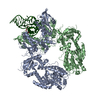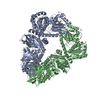+ Open data
Open data
- Basic information
Basic information
| Entry |  | |||||||||
|---|---|---|---|---|---|---|---|---|---|---|
| Title | SLFN11 WT dimer bound to tRNA-Leu-TAA (pre-cleavage state) | |||||||||
 Map data Map data | ||||||||||
 Sample Sample |
| |||||||||
 Keywords Keywords | tRNA / endoribonuclease activity / dimeric / HYDROLASE | |||||||||
| Function / homology |  Function and homology information Function and homology informationreplication fork arrest / negative regulation of G1/S transition of mitotic cell cycle / negative regulation of DNA replication / site of DNA damage / immune system process / helicase activity / endonuclease activity / defense response to virus / Hydrolases; Acting on ester bonds / tRNA binding ...replication fork arrest / negative regulation of G1/S transition of mitotic cell cycle / negative regulation of DNA replication / site of DNA damage / immune system process / helicase activity / endonuclease activity / defense response to virus / Hydrolases; Acting on ester bonds / tRNA binding / chromatin remodeling / DNA damage response / ATP hydrolysis activity / DNA binding / nucleoplasm / ATP binding / nucleus / cytosol Similarity search - Function | |||||||||
| Biological species |  Homo sapiens (human) Homo sapiens (human) | |||||||||
| Method | single particle reconstruction / cryo EM / Resolution: 3.0 Å | |||||||||
 Authors Authors | Kugler M / Metzner FJ / Lammens K | |||||||||
| Funding support |  Germany, European Union, 2 items Germany, European Union, 2 items
| |||||||||
 Citation Citation |  Journal: Nat Commun / Year: 2024 Journal: Nat Commun / Year: 2024Title: Phosphorylation-mediated conformational change regulates human SLFN11. Authors: Michael Kugler / Felix J Metzner / Gregor Witte / Karl-Peter Hopfner / Katja Lammens /  Abstract: Human Schlafen 11 (SLFN11) is sensitizing cells to DNA damaging agents by irreversibly blocking stalled replication forks, making it a potential predictive biomarker in chemotherapy. Furthermore, ...Human Schlafen 11 (SLFN11) is sensitizing cells to DNA damaging agents by irreversibly blocking stalled replication forks, making it a potential predictive biomarker in chemotherapy. Furthermore, SLFN11 acts as a pattern recognition receptor for single-stranded DNA (ssDNA) and functions as an antiviral restriction factor, targeting translation in a codon-usage-dependent manner through its endoribonuclease activity. However, the regulation of the various SLFN11 functions and enzymatic activities remains enigmatic. Here, we present cryo-electron microscopy (cryo-EM) structures of SLFN11 bound to tRNA-Leu and tRNA-Met that give insights into tRNA binding and cleavage, as well as its regulation by phosphorylation at S219 and T230. SLFN11 phosphomimetic mutant S753D adopts a monomeric conformation, shows ATP binding, but loses its ability to bind ssDNA and shows reduced ribonuclease activity. Thus, the phosphorylation site S753 serves as a conformational switch, regulating SLFN11 dimerization, as well as ATP and ssDNA binding, while S219 and T230 regulate tRNA recognition and nuclease activity. | |||||||||
| History |
|
- Structure visualization
Structure visualization
| Supplemental images |
|---|
- Downloads & links
Downloads & links
-EMDB archive
| Map data |  emd_51456.map.gz emd_51456.map.gz | 230.1 MB |  EMDB map data format EMDB map data format | |
|---|---|---|---|---|
| Header (meta data) |  emd-51456-v30.xml emd-51456-v30.xml emd-51456.xml emd-51456.xml | 15.8 KB 15.8 KB | Display Display |  EMDB header EMDB header |
| FSC (resolution estimation) |  emd_51456_fsc.xml emd_51456_fsc.xml | 13.2 KB | Display |  FSC data file FSC data file |
| Images |  emd_51456.png emd_51456.png | 147.9 KB | ||
| Masks |  emd_51456_msk_1.map emd_51456_msk_1.map | 244.1 MB |  Mask map Mask map | |
| Filedesc metadata |  emd-51456.cif.gz emd-51456.cif.gz | 6.1 KB | ||
| Others |  emd_51456_half_map_1.map.gz emd_51456_half_map_1.map.gz emd_51456_half_map_2.map.gz emd_51456_half_map_2.map.gz | 226.3 MB 226.3 MB | ||
| Archive directory |  http://ftp.pdbj.org/pub/emdb/structures/EMD-51456 http://ftp.pdbj.org/pub/emdb/structures/EMD-51456 ftp://ftp.pdbj.org/pub/emdb/structures/EMD-51456 ftp://ftp.pdbj.org/pub/emdb/structures/EMD-51456 | HTTPS FTP |
-Validation report
| Summary document |  emd_51456_validation.pdf.gz emd_51456_validation.pdf.gz | 1 MB | Display |  EMDB validaton report EMDB validaton report |
|---|---|---|---|---|
| Full document |  emd_51456_full_validation.pdf.gz emd_51456_full_validation.pdf.gz | 1 MB | Display | |
| Data in XML |  emd_51456_validation.xml.gz emd_51456_validation.xml.gz | 22.3 KB | Display | |
| Data in CIF |  emd_51456_validation.cif.gz emd_51456_validation.cif.gz | 29 KB | Display | |
| Arichive directory |  https://ftp.pdbj.org/pub/emdb/validation_reports/EMD-51456 https://ftp.pdbj.org/pub/emdb/validation_reports/EMD-51456 ftp://ftp.pdbj.org/pub/emdb/validation_reports/EMD-51456 ftp://ftp.pdbj.org/pub/emdb/validation_reports/EMD-51456 | HTTPS FTP |
-Related structure data
| Related structure data |  9gmwMC  9erdC  9ereC  9erfC  9gmxC M: atomic model generated by this map C: citing same article ( |
|---|---|
| Similar structure data | Similarity search - Function & homology  F&H Search F&H Search |
- Links
Links
| EMDB pages |  EMDB (EBI/PDBe) / EMDB (EBI/PDBe) /  EMDataResource EMDataResource |
|---|
- Map
Map
| File |  Download / File: emd_51456.map.gz / Format: CCP4 / Size: 244.1 MB / Type: IMAGE STORED AS FLOATING POINT NUMBER (4 BYTES) Download / File: emd_51456.map.gz / Format: CCP4 / Size: 244.1 MB / Type: IMAGE STORED AS FLOATING POINT NUMBER (4 BYTES) | ||||||||||||||||||||||||||||||||||||
|---|---|---|---|---|---|---|---|---|---|---|---|---|---|---|---|---|---|---|---|---|---|---|---|---|---|---|---|---|---|---|---|---|---|---|---|---|---|
| Projections & slices | Image control
Images are generated by Spider. | ||||||||||||||||||||||||||||||||||||
| Voxel size | X=Y=Z: 0.727 Å | ||||||||||||||||||||||||||||||||||||
| Density |
| ||||||||||||||||||||||||||||||||||||
| Symmetry | Space group: 1 | ||||||||||||||||||||||||||||||||||||
| Details | EMDB XML:
|
-Supplemental data
-Mask #1
| File |  emd_51456_msk_1.map emd_51456_msk_1.map | ||||||||||||
|---|---|---|---|---|---|---|---|---|---|---|---|---|---|
| Projections & Slices |
| ||||||||||||
| Density Histograms |
-Half map: #1
| File | emd_51456_half_map_1.map | ||||||||||||
|---|---|---|---|---|---|---|---|---|---|---|---|---|---|
| Projections & Slices |
| ||||||||||||
| Density Histograms |
-Half map: #2
| File | emd_51456_half_map_2.map | ||||||||||||
|---|---|---|---|---|---|---|---|---|---|---|---|---|---|
| Projections & Slices |
| ||||||||||||
| Density Histograms |
- Sample components
Sample components
-Entire : SLFN11 WT dimer bound to tRNA-Leu-TAA (pre-cleavage state)
| Entire | Name: SLFN11 WT dimer bound to tRNA-Leu-TAA (pre-cleavage state) |
|---|---|
| Components |
|
-Supramolecule #1: SLFN11 WT dimer bound to tRNA-Leu-TAA (pre-cleavage state)
| Supramolecule | Name: SLFN11 WT dimer bound to tRNA-Leu-TAA (pre-cleavage state) type: organelle_or_cellular_component / ID: 1 / Parent: 0 / Macromolecule list: #1-#2 |
|---|---|
| Source (natural) | Organism:  Homo sapiens (human) Homo sapiens (human) |
-Macromolecule #1: Schlafen family member 11
| Macromolecule | Name: Schlafen family member 11 / type: protein_or_peptide / ID: 1 / Number of copies: 2 / Enantiomer: LEVO / EC number: Hydrolases; Acting on acid anhydrides |
|---|---|
| Source (natural) | Organism:  Homo sapiens (human) Homo sapiens (human) |
| Molecular weight | Theoretical: 106.207914 KDa |
| Recombinant expression | Organism:  Trichoplusia ni (cabbage looper) Trichoplusia ni (cabbage looper) |
| Sequence | String: MADYKDDDDK GTDYKDDDDK LEVLFQGPME ANQCPLVVEP SYPDLVINVG EVTLGEENRK KLQKIQRDQE KERVMRAACA LLNSGGGVI RMAKKVEHPV EMGLDLEQSL RELIQSSDLQ AFFETKQQGR CFYIFVKSWS SGPFPEDRSV KPRLCSLSSS L YRRSETSV ...String: MADYKDDDDK GTDYKDDDDK LEVLFQGPME ANQCPLVVEP SYPDLVINVG EVTLGEENRK KLQKIQRDQE KERVMRAACA LLNSGGGVI RMAKKVEHPV EMGLDLEQSL RELIQSSDLQ AFFETKQQGR CFYIFVKSWS SGPFPEDRSV KPRLCSLSSS L YRRSETSV RSMDSREAFC FLKTKRKPKI LEEGPFHKIH KGVYQELPNS DPADPNSDPA DLIFQKDYLE YGEILPFPES QL VEFKQFS TKHFQEYVKR TIPEYVPAFA NTGGGYLFIG VDDKSREVLG CAKENVDPDS LRRKIEQAIY KLPCVHFCQP QRP ITFTLK IVNVLKRGEL YGYACMIRVN PFCCAVFSEA PNSWIVEDKY VCSLTTEKWV GMMTDTDPDL LQLSEDFECQ LSLS SGPPL SRPVYSKKGL EHKKELQQLL FSVPPGYLRY TPESLWRDLI SEHRGLEELI NKQMQPFFRG ILIFSRSWAV DLNLQ EKPG VICDALLIAQ NSTPILYTIL REQDAEGQDY CTRTAFTLKQ KLVNMGGYTG KVCVRAKVLC LSPESSAEAL EAAVSP MDY PASYSLAGTQ HMEALLQSLV IVLLGFRSLL SDQLGCEVLN LLTAQQYEIF SRSLRKNREL FVHGLPGSGK TIMAMKI ME KIRNVFHCEA HRILYVCENQ PLRNFISDRN ICRAETRKTF LRENFEHIQH IVIDEAQNFR TEDGDWYGKA KSITRRAK G GPGILWIFLD YFQTSHLDCS GLPPLSDQYP REELTRIVRN ADPIAKYLQK EMQVIRSNPS FNIPTGCLEV FPEAEWSQG VQGTLRIKKY LTVEQIMTCV ADTCRRFFDR GYSPKDVAVL VSTAKEVEHY KYELLKAMRK KRVVQLSDAC DMLGDHIVLD SVRRFSGLE RSIVFGIHPR TADPAILPNV LICLASRAKQ HLYIFPWGGH UniProtKB: Schlafen family member 11 |
-Macromolecule #2: RNA (86-MER)
| Macromolecule | Name: RNA (86-MER) / type: rna / ID: 2 / Number of copies: 1 |
|---|---|
| Source (natural) | Organism:  Homo sapiens (human) Homo sapiens (human) |
| Molecular weight | Theoretical: 27.700455 KDa |
| Sequence | String: ACCAGGAUGG CCGAGUGGUU AAGGCGUUGG ACUUAAGAUC CAAUGGACAU AUGUCCGCGU GGGUUCGAAC CCCACUCCUG GUACCA |
-Macromolecule #3: ZINC ION
| Macromolecule | Name: ZINC ION / type: ligand / ID: 3 / Number of copies: 2 / Formula: ZN |
|---|---|
| Molecular weight | Theoretical: 65.409 Da |
-Macromolecule #4: MANGANESE (II) ION
| Macromolecule | Name: MANGANESE (II) ION / type: ligand / ID: 4 / Number of copies: 3 / Formula: MN |
|---|---|
| Molecular weight | Theoretical: 54.938 Da |
-Macromolecule #5: MAGNESIUM ION
| Macromolecule | Name: MAGNESIUM ION / type: ligand / ID: 5 / Number of copies: 4 / Formula: MG |
|---|---|
| Molecular weight | Theoretical: 24.305 Da |
-Experimental details
-Structure determination
| Method | cryo EM |
|---|---|
 Processing Processing | single particle reconstruction |
| Aggregation state | particle |
- Sample preparation
Sample preparation
| Buffer | pH: 7.5 |
|---|---|
| Vitrification | Cryogen name: ETHANE |
- Electron microscopy
Electron microscopy
| Microscope | FEI TITAN KRIOS |
|---|---|
| Image recording | Film or detector model: FEI FALCON IV (4k x 4k) / Average electron dose: 40.0 e/Å2 |
| Electron beam | Acceleration voltage: 300 kV / Electron source:  FIELD EMISSION GUN FIELD EMISSION GUN |
| Electron optics | Illumination mode: FLOOD BEAM / Imaging mode: BRIGHT FIELD / Nominal defocus max: 2.6 µm / Nominal defocus min: 0.5 µm |
| Experimental equipment |  Model: Titan Krios / Image courtesy: FEI Company |
 Movie
Movie Controller
Controller








 Z (Sec.)
Z (Sec.) Y (Row.)
Y (Row.) X (Col.)
X (Col.)














































